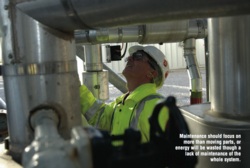Maintaining energy efficiency

Maintenance should focus on more than moving parts, or energy will be wasted though a lack of maintenance of the whole system.
Maintenance should be a key element of any energy management strategy — but often is not. SIMON YEATES explains the benefits of taking a more holistic approach It is unfortunate that many building operators take a rather piecemeal approach to energy management. In doing so, they fail to achieve maximum efficiency. As energy prices continue to rise and regulatory pressures on energy efficiency become increasingly stringent, it is time to take a closer look at the full picture. In the past, one of the barriers to encouraging such an approach has been the deregulation of the energy markets. This created a commercial environment where organisations could negotiate keen tariffs as the utilities fought for market share, so there was less incentive to look hard at energy consumption to save money.
New momentum That particular bubble has now has now burst with an almighty bang, and many building operators are receiving some very unpleasant surprises when their energy bills arrive. As the motivation for reducing energy consumption takes on a new momentum, there is a great opportunity for the building-services industry to help its customers achieve the savings they desire. To that end, the most effective way to manage energy consumption is to take an holistic approach that identifies every potential area for savings and incorporates measures to maximise them. As most of a building’s energy consumption comes from its services (with the exception of factories), this is the obvious place to start. Very often, the first thing that building operators address is how their services are controlled. If the existing controls are rudimentary, retrofitting even relatively simple controls can yield significant savings. Unfortunately, once that has been achieved, there is a tendency for people to tick the box and rest on their laurels instead of going for maximum savings. Controls are great for adjusting run time and capacity, but they do not ensure that the plant is efficient when it is running. That is the job of the maintenance regime. All too often, however, maintenance is just seen as a way of making sure equipment does not break down. As a result, when maintenance is considered, the focus is on operational standards and requirements, and these considerations are treated in isolation from other aspects. There are many reasons why this traditional approach needs to change.
More effective Far more effective is to consider building-services management as a function that incorporates energy procurement and management, lifecycle costing incorporating future funding for planned equipment replacement, and risk transfer from the client to the building-services maintenance company. In this way, building-services management becomes far more than simply maintaining the building’s plant.
A fresh look at PPM The conventional approach to planned preventative maintenance (PPM) is to concentrate on the moving parts, with the result that static plant such and pipes and ductwork is overlooked. However, a build up of limescale in pipework will restrict the diameter of the pipes and make the pumps work harder to circulate the same volume of water. Similarly, a build up of debris in ductwork and on grilles increases resistance to airflow so that fans operate for longer periods, or at a higher speed if they are inverter controlled. Lack of maintenance of the whole system thus wastes energy. An alternative approach to conventional PPM is for the maintenance contractor to also take responsibility for energy consumption, with payments directly linked to pre-set consumption targets. This gives the contractor a vested interest in ensuring systems are running at maximum efficiency. This concept of paying for performance is, of course, not new. Risk transference arrived in the 1990s via PFI schemes and has since impacted on public-sector contracts. Both PPP and LIFT contracts focus on establishing client/supplier partnerships and shared risks — increasing emphasis on measuring performance within environmental conditions (temperature, humidity etc.), system efficiencies (boilers, chillers), energy consumptions, the standard of maintenance delivered, lifecycle forecasts, and capital spend. Moving a step further, the maintenance/energy management contractor can also be given the responsibility for ensuring continuity of energy supply, replacing equipment and maintaining the building fabric to ensure the thermal elements complement the efficiency of the plant. An holistic approach will also include an audit regime to maintain a history of the plant and enable more informed decisions. For example, it may be more cost-effective to replace an item that has historically required high levels of remedial work than to continue maintaining it. With the likely introduction of building energy targets, albeit later than originally anticipated, and the inexorable rise in energy costs, it is time to take a fresh look at what constitutes best practice in energy management. An holistic approach certainly has the potential to save a great deal of money, reduce administration and provide peace of mind.
Simon Yeates is with Cofathec Heatsave, 46 Loman Street, London, SE1 0BA.
Related links:


